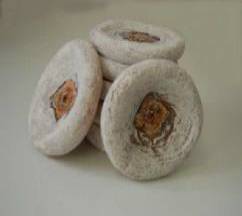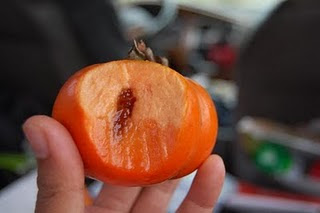You have to try persimmon because it is abundant only in autumn (which is my favourite season) or early winter. Some people called it as 'Pisang Kaki' in Malaysia. Don't mistake it for tomato because it does look like it but the taste is far from same.
I used to frequent Chinese traditional medicine shop with my parents to buy some herbs when I was small and I would ask them to buy some dried persimmon for me too. Never thought that it is the persimmon that I love eating so much in Korea! There are so many shops selling persimmon during autumn. I bought 3 for 1,000 won while visiting Korean Hanok Village near Chungmuro Subway Station.
Hachiya - Notice the difference in shape? It's kinda heart-shaped. However, you can only eat it when it's fully ripe. If you eat it before it's ripe, very bitter. I don't like Hachiya persimmon because it's kinda gooey when you consume it. Ack! Just like the picture below.
I used to frequent Chinese traditional medicine shop with my parents to buy some herbs when I was small and I would ask them to buy some dried persimmon for me too. Never thought that it is the persimmon that I love eating so much in Korea! There are so many shops selling persimmon during autumn. I bought 3 for 1,000 won while visiting Korean Hanok Village near Chungmuro Subway Station.
Dried persimmon
In Korea, there are 2 types of persimmon:
Fuyu - you can eat it when it is not fully ripe and it is still sweet (my favourite) and I like it when it is crunchy just like apple. The shape resembles tomato and in Korea it's called tam kam (단감). The taste is not that sweet. Have you have tried eating sugar cane? Almost like that.
Persimmon's Health Benefit
- source of vitamin A
- high in fiber
- contains shibuol and betulinic acid that are thought to have anti-cancer properties
- A study conducted in Japan showed that the peel of the persimmon contains phytochemicals known as proanthocyanidins which may protect cells against oxidative damage associated with aging. (Is this one of the reasons why Koreans look young?!!)
Get all your Persimmon related recipes at Epersimmon.
Check out my WWOOF trip to Jangheung where I helped the family picking persimmons.
For more information about persimmon, check out Wikipedia
Picking persimmon




댓글 쓰기